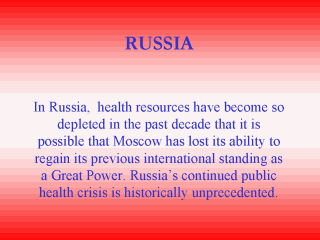 |
No other
industrialized country has ever experienced such a severe and prolonged deterioration
during peacetime. The loss of life from this health crisis in Russia has been a
catastrophe of historic proportions, which has been estimated by the World Health
Organization, for the period 1992-1995, as exceeding 1.8 million deaths, more than died
during the first World War. From the end of World War II to roughly 1960, the Soviet
system showed some dramatic improvement in Union-wide health levels; by 1960, life
expectancy at birth in Russia was comparable to American levels. But official figures
revealed that overall life expectancy for Russia was no higher in the late 1980s than it
had been in the early 1960s - and that for adults, life expectancy was actually somewhat
lower than it had been a quarter century earlier (Eberstadt, 1999). |
